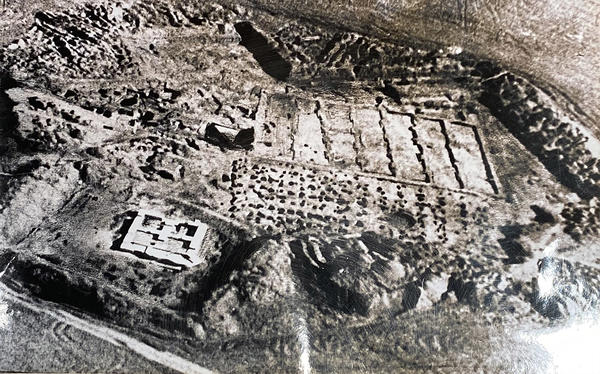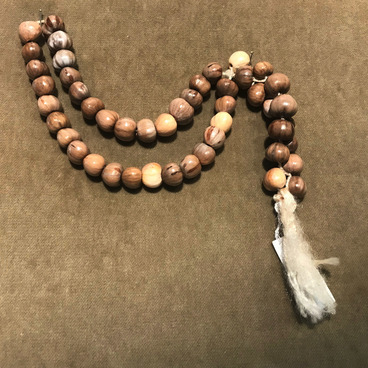The photo depicts the ruins of the pre-Mongolian period: of the Cathedral Mosque, the feudal house and the well. Bilyar mosque is recognized as one of the biggest buildings of Eastern Europe in the Middle Ages.
Another series of excavations was launched in 1971 under the supervision of Alfred Khasanovich Khalikov, and starting from the next year the team undertook detailed examination. In 1976-1981, the site was under scientific preservation.
The archaeologists discovered the remains of a great complex: foundation, the heelposts of the floor structures — 650 holes in total. The area inside all the buildings exceeded 2,000 square metres.
The ditch for minaret foundation is 1.2-1.5 metres to the Northeast of the mosque. The ‘feudal house’ discovered in 1971-1973 also belongs to this complex.
Farida Zabirova, the author of the aerial photograph, was the Assistant Professor of the Urban Planning Department of Kazan State University of Architecture and Construction, the expert of the Ministry of Culture of the Russian Federation.
According to Ibn Fadlan, the medieval explorer, the year of the foundation of the mosque was 992, the reign of Almush, the Bulgharian tsar. The first archaeological artefacts from Bilyar ancient town site we described back in the 10th century.
Bilyar was situated on the banks of the Maly Cheremshan River flowing into the Volga. Starting from the 12th century, Bilyar was the capital of Volga Bulgharia. The chronicles mention it for the last time in 1236. In that year, the Mongols attacked the Great City and burnt it. Many scientists believe that Bilyar descendants were the ancestors of bulyar medieval tribe, which is of Bulghar origin.
The archaeological remains of sometime great city — Bilyar site — are to the Southeast of Bilyarsk village.
Bilyar was situated on the banks of the Maly Cheremshan River flowing into the Volga. Starting from the 12th century, Bilyar was the capital of Volga Bulgharia. The chronicles mention it for the last time in 1236. In that year, the Mongols attacked the Great City and burnt it. Many scientists believe that Bilyar descendants were the ancestors of bulyar medieval tribe, which is of Bulghar origin.
The archaeological remains of sometime great city — Bilyar site — are to the Southeast of Bilyarsk village.
The cathedral mosque is inside the citadel. Historians knew about the mosque ruins in this location a long time ago. Vasily Tatishchev, a famous Russian scientist and explorer, described the ruined portal and the minarets. Nikolay Petrovich Rychkov, another Russian explorer, visited Bilyarsk in 1769 and wrote about the remains of buildings made of brick and stone.
Starting from the mid-19th century, the locals actively developed the once abandoned town, and archaeologists Pyotr Alexeyevich Ponomaryov and Mikhail Georgiyevich Khudyakov I 1915 could not find the ruins. During the excavations, they found only the remains of the foundation made of white stone.
Starting from the mid-19th century, the locals actively developed the once abandoned town, and archaeologists Pyotr Alexeyevich Ponomaryov and Mikhail Georgiyevich Khudyakov I 1915 could not find the ruins. During the excavations, they found only the remains of the foundation made of white stone.
Another series of excavations was launched in 1971 under the supervision of Alfred Khasanovich Khalikov, and starting from the next year the team undertook detailed examination. In 1976-1981, the site was under scientific preservation.
The archaeologists discovered the remains of a great complex: foundation, the heelposts of the floor structures — 650 holes in total. The area inside all the buildings exceeded 2,000 square metres.
The ditch for minaret foundation is 1.2-1.5 metres to the Northeast of the mosque. The ‘feudal house’ discovered in 1971-1973 also belongs to this complex.
Farida Zabirova, the author of the aerial photograph, was the Assistant Professor of the Urban Planning Department of Kazan State University of Architecture and Construction, the expert of the Ministry of Culture of the Russian Federation.


